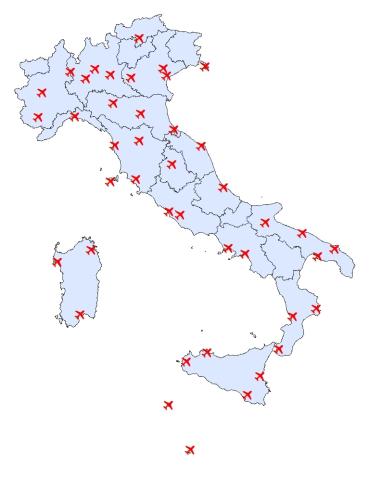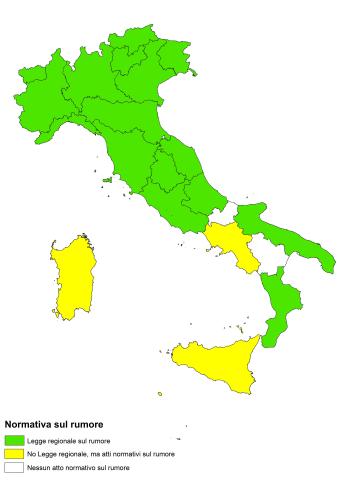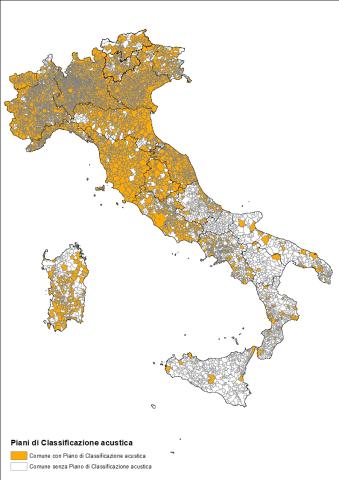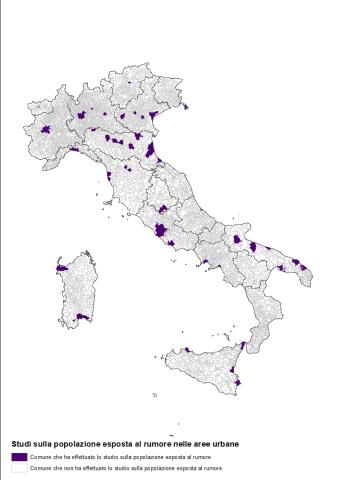STATUS OF APPROVAL OF MUNICIPAL NOISE MITIGATION PLANS
Data aggiornamento scheda:
The Municipal Noise Mitigation Plan is legally established as a fundamental tool for managing and resolving noise pollution issues within a territory. This plan follows the primary municipal requirement: the Noise Zoning Plan. The Noise Mitigation Plan must be coordinated with all other urban planning tools and must incorporate the content of noise containment and reduction plans for transport infrastructure. As of 2023, this planning instrument remains scarcely implemented at the national level: only 66 out of 5,097 municipalities with an approved Noise Zoning Plan have also adopted a Noise Mitigation Plan, maintaining a percentage slightly above 1% over the years.
STATUS OF IMPLEMENTATION OF AIRPORT SURROUNDINGS ACOUSTIC CHARACTERIZATION
Data aggiornamento scheda:

The management of noise pollution generated by airport infrastructures is carried out through the implementation of obligations set by current regulations. These include the approval of the acoustic characterization of the airport surroundings, a key territorial planning measure that regulates land use compatible with noise levels produced by the airport. Additionally, noise mitigation procedures are applied to minimize aircraft noise impact, along with the implementation and management of an airport noise monitoring system. To date, these obligations remain unfulfilled in many airports across the country. As of 2024, the acoustic characterization of the airport surroundings has been approved in 24 out of 42 airports handling national and international air traffic, 39 of which have been identified by ENAC as "airports of national interest", , marking a fundamental and priority step in the management of airport noise pollution.
NOISE OBSERVATORY - REGIONAL REGULATIONS
Data aggiornamento scheda:

The Framework Law on Noise Pollution (LQ 447/1995) requires regions and autonomous provinces to issue their own regulations defining a set of criteria, methods, and procedures necessary for the full implementation of the national law. Since the enactment of LQ 447/95, the regional legislative framework remains incomplete: five regions have yet to adopt a regional law on noise pollution, while some regions, lacking specific legislation, have issued specific regulatory acts.
CONTROLLED SOURCES AND PERCENTAGE OF THOSE EXCEEDING LIMITS
Data aggiornamento scheda:
Noise generated by transportation, industries, and other human activities is one of the main environmental problems and can cause various disturbances to the population. To limit noise pollution and regulate noise sources, national noise regulations (LQ 447/95 and its implementing decrees) have established limit values for different types of sources. These limits are divided into those for the outdoor environment (absolute emission and immission limits), based on municipal acoustic zoning, and limits for the interior of residential buildings (differential immission limits).
This indicator describes the monitoring activities conducted by ARPA/APPA through measurements to verify compliance with the legal limits, both outdoors and indoors, distinguishing among different types of sources (industrial activities, service and/or commercial activities, construction activities and temporary events, road, rail, airport, and port infrastructure). In 2023, as in previous years, the most frequently monitored sources were service and/or commercial activities (57.3% of all monitored sources), followed by industrial activities (31.5%). Among transport infrastructures, which account for 7.1% of monitored sources, roads were the most frequently controlled (5.2%).
STATUS OF IMPLEMENTATION OF MUNICIPAL NOISE ZONING PLANS
Data aggiornamento scheda:

The Noise Zoning Plan is the primary municipal planning tool for managing noise pollution. This plan involves dividing the municipal territory into acoustically homogeneous areas, each assigned specific noise limits. Its goal is to provide an essential tool for urban development planning and territorial protection from noise pollution.
As of 2023, the Noise Zoning Plan has been approved in 64% of municipalities nationwide. However, significant regional disparities persist in the application of this planning instrument.
POPULATION EXPOSED TO NOISE
Data aggiornamento scheda:

High noise levels can negatively impact well-being. Health effects of noise include stress, reduced psychological well-being, sleep disturbances, and cardiovascular issues.
With the enactment of Directive 2002/49/EC, the European Union established a common approach to preventing or reducing harmful effects of population exposure to environmental noise. This approach is based on determining environmental noise exposure, informing the public, and implementing local Action Plans. Noise-exposed populations are identified through acoustic mapping, based on common and standardized methodologies.
Acoustic mapping studies indicate that a significant portion of the population is exposed to noise levels exceeding World Health Organization (WHO) recommendations. Road traffic is the primary noise source.